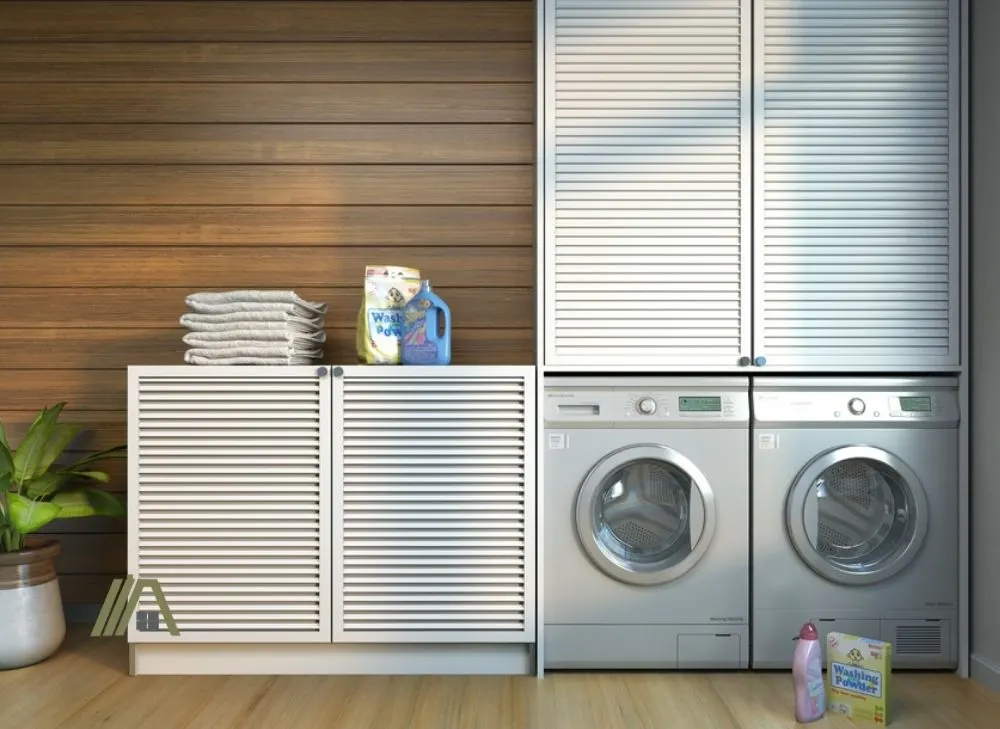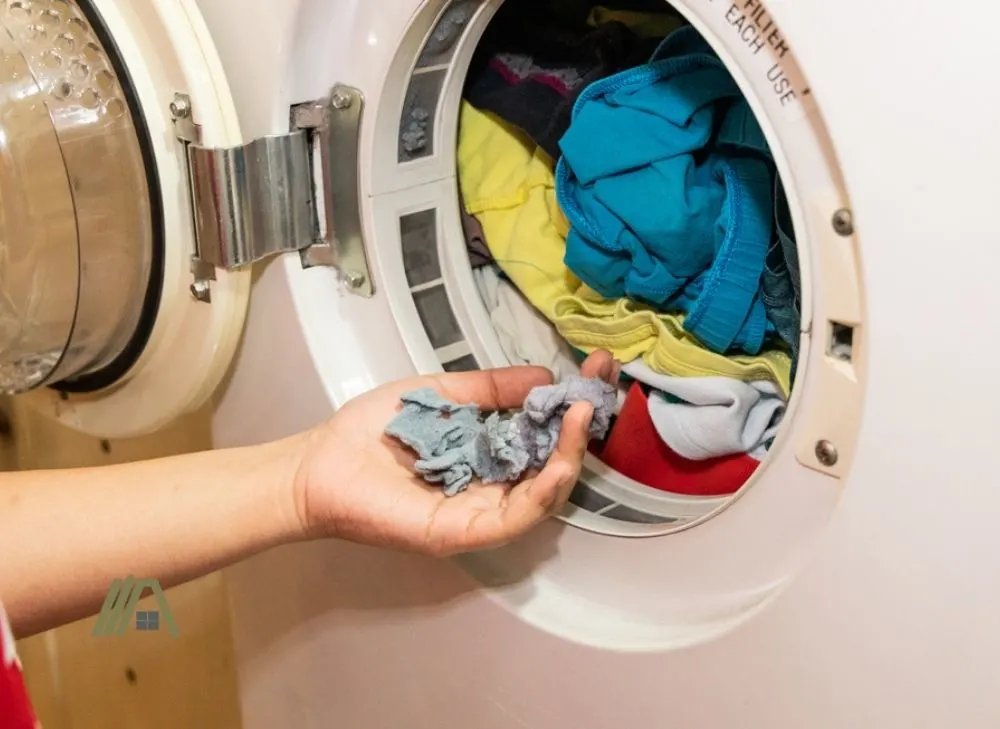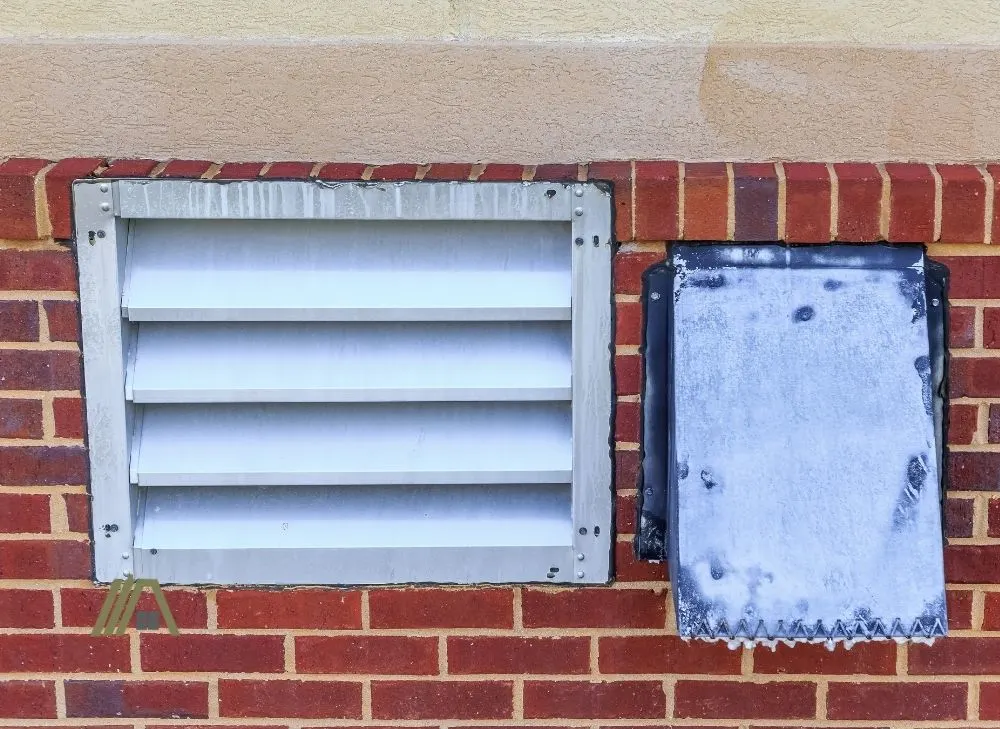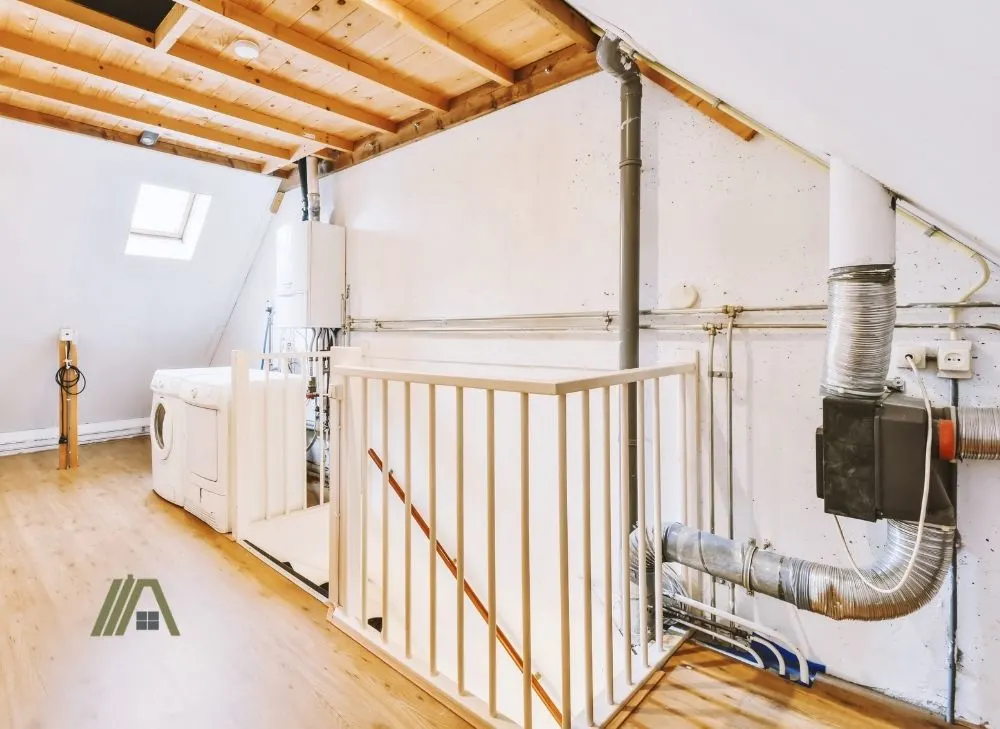Not all homes come equipped with perfect laundry room facilities that are situated perfectly to allow for easy venting of the dryer exhaust air to the outside. Venting this air outside is absolutely critical because it can negatively impact the structure of your home, the energy efficiency of the HVAC system, and even your health.
There are ways to properly vent dryers in the middle of the house, but there is also another, and in my opinion, a better option.

It’s better to buy a ventless dryer than to vent one from the middle of a house. If venting from the middle of a house, the duct can go up through the attic and out the roof. If there’s no attic access, the duct can run through the wall and adjacent rooms or down through the floor to the outside.
Rather Go Ventless
As mentioned, the venting of dryers is an essential component in any home for a number of reasons. However, venting is only necessary for dryers of the vented variety.

The quality of air in a room, the structural integrity of the house, and the health of the home’s inhabitants can still be upheld with the installation of a ventless dryer model.
These models adequately deal with dryer exhaust and come with a whole lot of advantages and a few disadvantages, which we will discuss shortly.
But before we get there, you might be wondering what happens to the dryer exhaust in these ventless dryers.
Where Does the Exhaust Go in Ventless Dryers?
Essentially, ventless dryers recycle the exhaust so that it’s incorporated back into the drying cycle. There are two ways in which the dryer does this.
One of the ways is through a condensation process. Condenser dryers take in air from the room, heat it, and pass it into the drum to dry the clothes. The now hot and humid air is then passed through a cooling device.
Once in the cooling device or heat exchanger, the moisture that condenses out of the cold air (cold air cannot hold as much moisture as hot air) is collected into a containment chamber.
The air is reheated and the cycle repeats until the clothes are dry. The cool, dry air is then released after its final cycle.
Eventually, the containment chamber holding the water will need to be manually emptied unless it is plumbed into the drainage system.
Similarly, a heat pump dryer draws in air from the room. The air is heated by a condenser in the heat pump and blown through the drum before entering the evaporator, where it is cold and the water is condensed out. This air then passes back into the condenser to be heated again.
Once the cycle is complete, the cool dry air is released into the room.
Things You Gain With Ventless Dryers
You Don’t Have to Install Ductwork
A huge advantage to using a ventless dryer is the freedom of location.
While the International Residential Code (IRC) says that exhaust duct systems must be provided where space for a clothes dryer is provided (Section M1502.4.8), this is not always everyone’s preferred location for a dryer.
Furthermore, the IRC has an exception to this regulation and that is if a ductless clothes dryer is installed from the start.
This means that, if you are using a vented dryer, you will have to install ducting to accommodate your preferred location as well as all of the necessary and advantageous accessories, such as backdraft dampers and duct insulation.
Depending on your situation, installing ductwork may not be an appealing option. Cutting holes in your walls, ceilings, or potentially your roof becomes more than a DIY project very quickly. There are also a number of regulations and guidelines that must be followed when venting for a dryer.
All of this, in addition to what it will cost for the hired labor and the venting itself. Do yourself a favor: avoid it! Simply opt for a ventless dryer.
You Don’t Have to Maintain Ductwork
If you don’t have ductwork, you don’t have to maintain it! Believe it or not, there’s more work that goes into maintaining the ducts connected to your dryer.
While the trap on the dryer collects a good amount of the lint from each cycle, some of it is still left in the actual venting. Lint build-up is bad for a number of reasons spanning from causing leaks to causing fires.

An easy way to tell if your vents need to be cleaned is based on your clothes. If your clothes are coming out damp after a full cycle, then it’s a good indication that your ducts need to be cleaned out.
Note: it may also be a sign that your dryer belt is broken or the heating element has burnt out.
Aside from cleaning them out, ductwork can also lead to other problems. Backdraft dampers, which are mandatory with vented dryers, regulate the flow of air so that it goes in one direction only. These devices have been known to make noises as well as allow cool drafts into the house.
Ventless Dryers Are Energy-Efficient
Another benefit of using a ventless dryer is the energy efficiency of its processes. While both types of ventless dryers can save on energy costs, models utilizing a heat pump are especially efficient.
While there are a few minor inconveniences that come with a heat pump dryer, it runs on nearly half of the energy a condensation dryer does. Decide for yourself if the pros of heat pump dryers outweigh the cons.
Clothes Last Longer With Ventless Dryers
Ventless dryers tend to operate at lower temperatures, especially heat pump dryers, causing them to take slightly longer than a vented dryer to dry a load of clothes. However, since the temperatures are cooler, your clothes will last longer.

The cooler temperatures of a ventless dryer put less stress on fabrics and ensure that your clothes are not over-dried.
What You Give Up with Ventless Dryers
Cannot Have a Gas Dryer
Many consumers spring to the idea of using a gas dryer because of the energy cost savings in the long run. If you’re looking to use a ventless model, this is no longer an option.
Gas dryers require electricity, but much less than fully electric dryers; they can be powered by a standard 120V outlet. However, since ventless models cannot run on gas due to the safety risk of carbon monoxide production, a 240V outlet is required.
If this is not readily available in your home, it will need to be installed near the dryer. If you already have a 240V outlet but it is in another room, you cannot use this because extension cords are dangerous with electric dryers.
Although installing a 240V outlet may pose a slight complication, in the long run, it will be worth it. When taking the cost of installing and maintaining a duct and vent system into consideration, a 240V outlet for a ventless dryer will begin to look much more appealing.
Load Capacity is Smaller
In most cases, a ventless dryer’s drum size is smaller in comparison to a vented model. Therefore, the amount of clothes that can fit in a single load is reduced.
Even with a size reduction, a ventless dryer is still a viable option. Ventless dryers are not so small that they cannot fulfill the needs of a domestic situation.
Drying Time is Increased
As briefly mentioned earlier, the cycle of a ventless dryer does take longer than a vented dryer. However, much like the load size discussed above, this should not be the reason you don’t purchase a ventless dryer.
Weather permitting, there’s nothing wrong with letting your clothes hang outside and air dry on the clothesline before tossing them in the dryer. This would make up for the time of a longer tumble cycle. Besides, you should never put soaking wet clothes into any dryer.
Habits like this may reap other benefits as well. Hanging clothes on the line ahead of time saves them from the heat of the dryer, thus preserving the fabric.
Overall, my opinion is that ventless dryers are a great idea and absolutely worth the extra upfront cost. If you are still unsure, I have a more comprehensive pros and cons list that you can read.
Vented Dryers Must Vent Outside
If you’d still rather have a vented dryer model, there are a few elements to consider.

Section M1502.3 of the IRC states that all exhaust ducts must terminate on the outside of the building.
This means that you cannot vent a dryer into the nearest room with a window or exhaust fan; it has to vent all the way outside.
Additionally, you cannot use the indoor dryer vent kits or condenser boxes that are being marketed these days. Indoor dryer vent kits are particularly ineffective when it comes to controlling moisture problems that can arise from dryer exhaust.
Along with that come other regulations regarding the ducts and vents. Dryer exhaust ducts must be made of a specific material and be the correct size. There are also specific instructions for installation to be up to code.
You Must Consider the Maximum Allowable Distance
I mentioned very briefly in the preceding section that ducts must be of the correct size. According to the IRC, the maximum allowable length of an exhaust duct is 35 feet.
It also should be noted that you cannot create a maze of ducts in the ceiling in order to reach a suitable vent point. For every elbow or bend, the maximum allowable distance decreases by a certain amount which can be found in Section M1502.4.6 of the IRC.
Room Is Below Attic
If your laundry room is directly below an attic, this makes the installation of a vent and outlet terminal much easier. Simply vent up through the ceiling into the attic and out of the roof.
The important thing to remember here is that you cannot terminate in the attic and it must go out through the roof. Not only is this not allowed, but it would cause warm, moist air to fill your attic. This could bring on a flurry of problems, including the rotting of the framework in the attic.
A common issue with venting through an attic (unless it is insulated) is condensation. Condensation can be controlled with an upward sloping vent pipe that leads toward the exhaust opening.

The upward slope allows whatever moisture that builds up in the vent to slide back down toward the dryer instead of pooling in the metal pipes and causing rust.
No Ceiling or Space In Ceiling
If the room for your dryer is not located underneath an attic, then you’re going to have to find another solution.
Vent Through Adjacent Rooms
You might have to vent through an adjacent room. In order to do this, you will have to cut a hole through the wall to make way for the ducts. Once in the next room, you’ll need to find a way to reach the exterior. Rather than going up, it’s best to vent through the soffit.
Venting through the soffit is permitted by the IRC unless the dryer’s exhaust exit is less than 3 feet from the ventilated soffit panels. Although venting through the soffit is less common than through the roof, it does have its advantages.
It is less likely for backdrafts or leakages to come back into the house when you vent through the soffit. Due to the angle that the exhaust vent would be at on the underside of your roof, it is very difficult for any wind or rain to enter through the vent.
To hide the metal ducting traveling through the adjacent room to an exterior wall, you can install a bulkhead.
Obviously, there are pros and cons to venting through adjacent rooms.
Pros:
- It allows you to still have a vented dryer with its larger load capacity and quicker drying time, which may be necessary if you run a bed and breakfast or something similar and you have lots of bedding to wash frequently.
- Installation is relatively easy because you don’t have to climb into the ceiling; you simply work from within the rooms.
Cons:
- Insulating the ductwork becomes less optional because the dryer air in the pipes affects the temperature of the rooms that it is running through. If not managed correctly, this can increase energy bills as well as make the rooms uncomfortable.
- Even with bulkheads hiding the pipes, the aesthetic of the adjacent rooms is going to be affected. It can even make them appear smaller as portions of the “ceiling” will be lower.
- Dryer ducts are not quiet, so the rooms that they run through will be affected by this noise.
- If the wall into the adjacent room is a structural or load-bearing wall, you have to be very careful about cutting holes into it.
Venting Down Through The Floor
Venting through the floor is somewhat similar to venting through an adjacent wall.
- You’ll want to identify the shortest route possible so that the venting doesn’t exceed 35 feet. (minus whatever length is lost with the use of elbows and bends).
- Next, you’ll trace the vent onto the floor and cut the hole. It’s not a bad idea to make the hole slightly larger than the vent to ensure it fits through.
- When cutting through the floor, you need to be mindful of any potential hazards. This could include wires, plumbing, pipes for underfloor heating, or anything else that’s crucial to the structure of the home.
- Once you’ve designated an area to cut a hole, you’ll just need to find an area where the exhaust can reach the exterior.
One of the advantages of venting through a floor is that you avoid cutting into your roof. Going down through the floor and out the exterior another way also makes it more accessible as opposed to climbing into an attic or even onto the roof.
Unfortunately, venting down makes the dryer’s blower motor work harder to move the hot air that naturally wants to rise.
Sources
https://www.pcrichard.com/vented-vs-ventless-dryers-whats-the-difference/Blog-9873.html
https://www.whirlpool.com/blog/washers-and-dryers/what-is-a-ventless-dryer.html
https://www.thespruce.com/how-ventless-dryers-work-2145837
https://www.ajmadison.com/learn/cooking/how-to/how-ventless-dryers-save-space-and-energy/
https://homeguides.sfgate.com/can-dryer-vent-up-through-attic-89540.html
http://www.appliance-repair-it.com/dryer-vent-installation.html
https://www.inman.com/2011/10/25/2-big-problems-with-venting-dryer-vertically/
